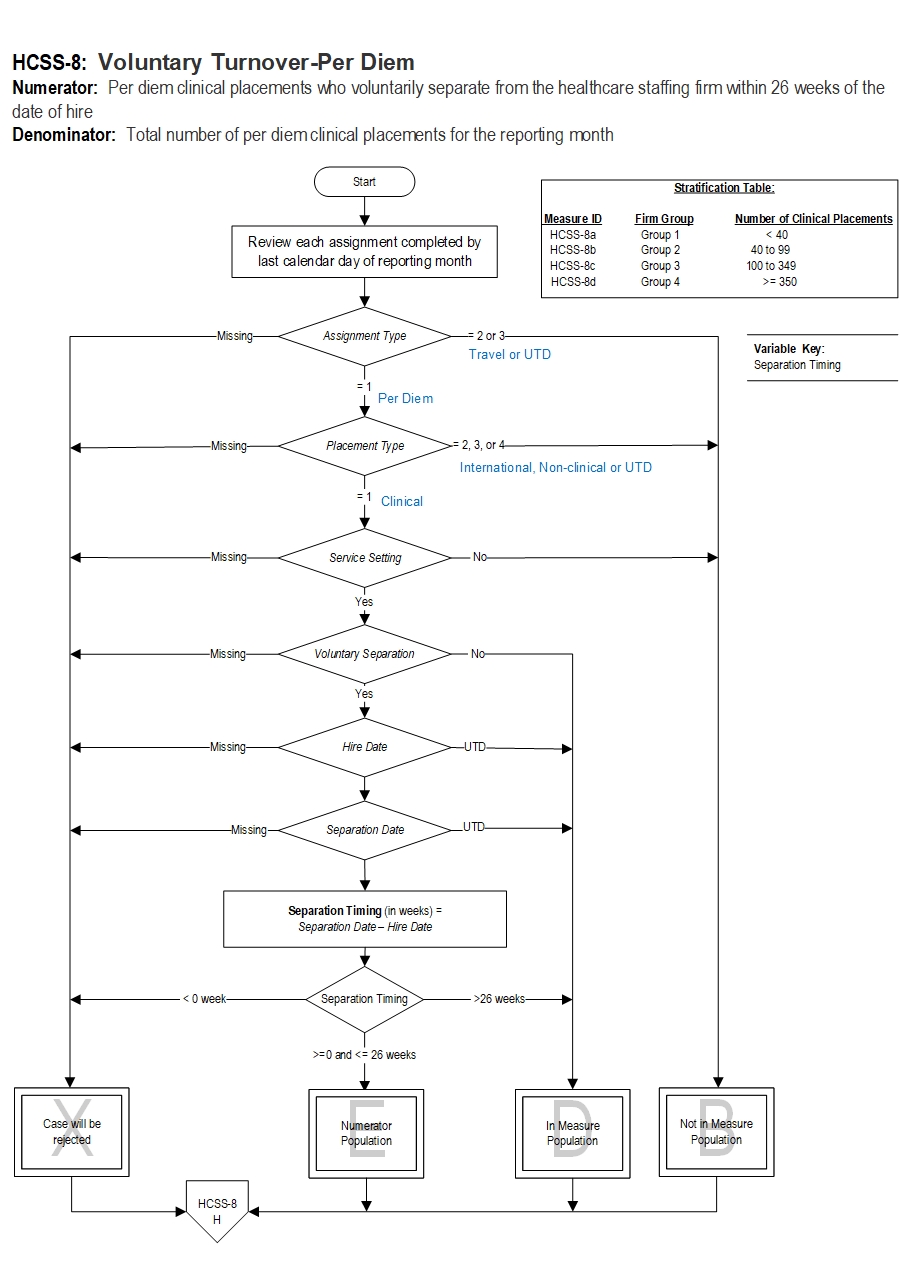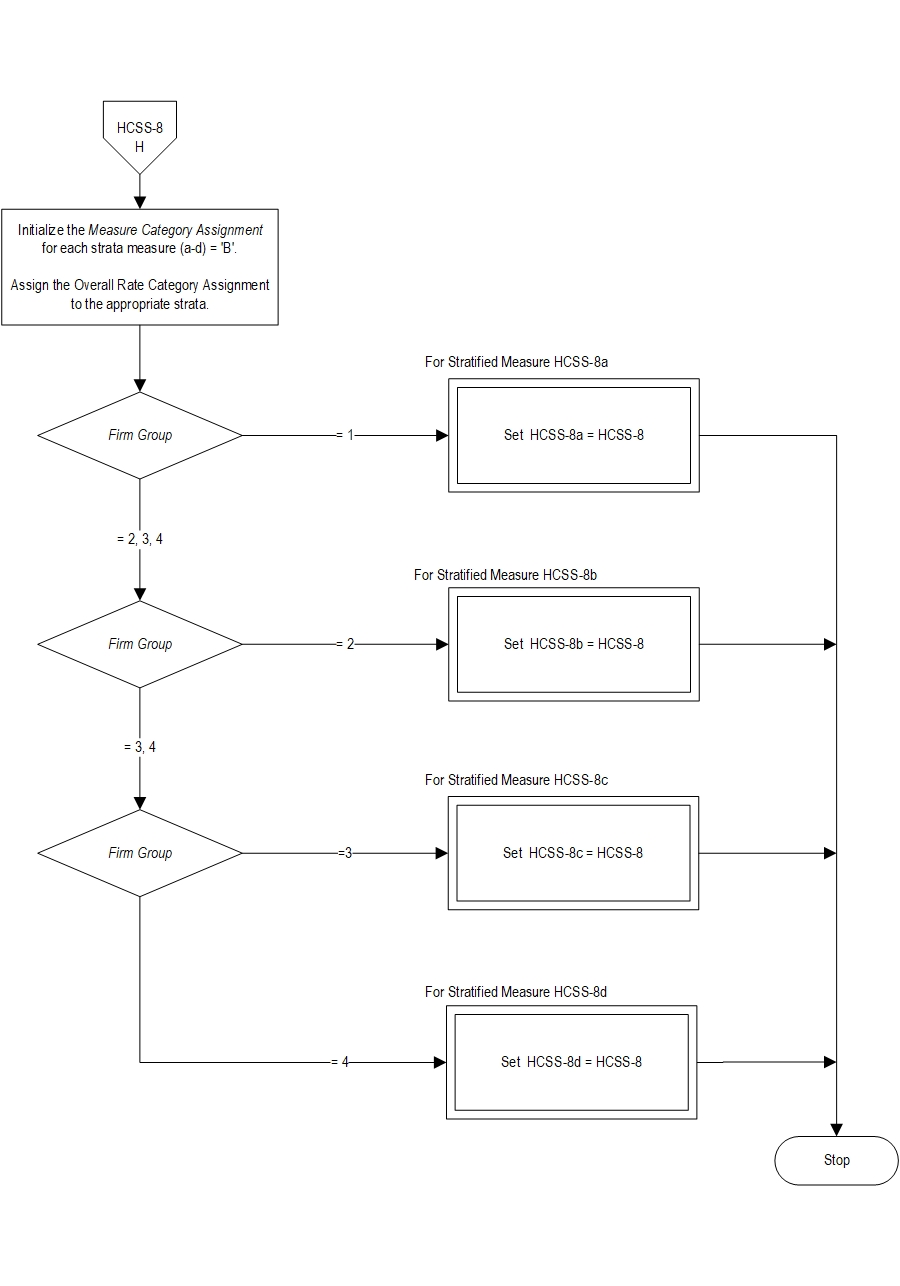Measure Information Form
Version 2023B
Measure Information Form
The HCSS-8 measure is reported as a percentage which includes per diem clinical placements only. Firms may provide per diem staffing assignments only, travel staffing assignments only, or both per diem and travel staffing assignments. Data are reported monthly. NOTE: This measure is NOT reported by healthcare staffing firms with no per diem clinical staff.
Data are reported based on the size of the firm as determined by the total number of clinical placements identified for each site requesting certification in the certification application. The size of the firm is defined as the total number of clinical placements (i.e., employees) placed in a 12 month period by each site listed in the application, including allied health professionals, nursing professionals, and licensed independent practitioners (LIPs); excludes independent contractors, if the firm requested in its application that these individuals should not be included in the scope of the certification review.
The Joint Commission Connect® e-app should be used as a reference to select the appropriate size category for reporting. Only one category may be selected for each review cycle.
GROUP 1 < 40 clinical placementsGROUP 2 40 to 99 clinical placements
GROUP 3 100 to 349 clinical placements
GROUP 4 >= 350 clinical placements Rationale: A 2017 C-Suite Challenge Survey from the American Staffing Association (ASA) reported that nearly 80% of the respondents are evaluating their workforce composition and moving towards increased use of temporary and contract staff. Approximately 10% of all temporary staffing sales are in the healthcare sector. Service-providing sectors are projected to add more than 10.5 million jobs by 2026 (U.S. Bureau of Labor Statistics). Approximately one third of these jobs are projected for the healthcare sector. Richard Wahlquist, President and CEO, ASA thinks that “the future looks bright” for staffing firms that can continue to raise the bar, fill positions with talented, qualified staff, and deliver high quality workforce services and solutions (American Staffing Association, 2018).
Despite the many employment opportunities available to temporary and contract employees, the turnover rate increased to 386% in 2017 for all sectors with an average tenure of 10.7 weeks. Tenure and turnover are inversely related metrics (American Staffing Association, 2018). High turnover rates represent shorter periods of tenure at individual staffing firms. Lower turnover rates mean lower recruiting costs, administrative expenses and training costs, and other costs associated with recruiting and hiring new employees.
Jalonen and colleagues conducted a study of 412 nurses with temporary job contracts who reported being committed to their organization at baseline. Two years later, results demonstrated that age over 35 years, high job control, high participative safety, high perceived justice in decision-making, and low psychological stress were significant predictors of sustained organizational commitment. Of these factors, job control - the degree to which a job provides freedom and independence to the individual regarding the nature and timing of work - was the strongest predictor. Nurses who have higher job satisfaction are more likely to remain with the organization as compared to higher rates of turnover for dissatisfied employees (Jalonen, et al., 2006).
According to Lown and associates, (Lown, et al., 2020). research has clearly shown that employee engagement is linked to organizational performance and organizational outcomes, including employee retention, customer loyalty, productivity, and profit. Employees who feel valued and cared about at work identify with the organization and develop a sense of organizational commitment, thus reducing the cost of avoidable turnover.
Turnover is an important performance measure for healthcare staffing firms to monitor over time. Healthcare staffing leaders should pay careful attention to the employees’ opportunities for job control and participative decision-making. Employee desire for permanent employment may also be a driver of turnover and should be assessed at the time of hire and periodic intervals thereafter.
Type Of Measure: Process Improvement Noted As: Decrease in the rateIncluded Populations: Not applicable Excluded Populations: None Data Elements:Denominator Statement: Total number of per diem clinical placements for the reporting month
Included Populations:Excluded Populations:
- Per Diem assignments, AND
- Clinical placements, AND
- Placements in a Service Setting
Data Elements:
- International placements
- Non-clinical placements
- Travel staff assignments
Setting: Health Care Staffing Services
Report Period: Quarterly with monthly data points Selected References:
- American Staffing Association. ASA Annual Economic Analysis Staffing Industry Playbook. Staffing Success, The Magazine of the American Staffing Association, Special Edition. 2018: 9-53.
- Jalonen P, Virtanen M, Vahtera J, Elovainio M, Kivimäki M. Predictors of Sustained Organizational Commitment Among Nurses With Temporary Job Contracts. JONA.2006;36(5): 268-276.
- Lown AB, Manning CF, Hassmiller SB. Does Organizational Compassion Matter? A Cross-sectional Survey of Nurses. JONA.2020;50(2): 78-84.
- U.S. Bureau of Labor Statistics. 2018.

